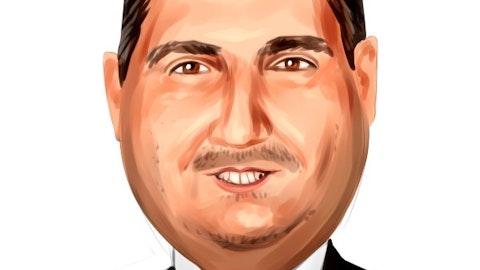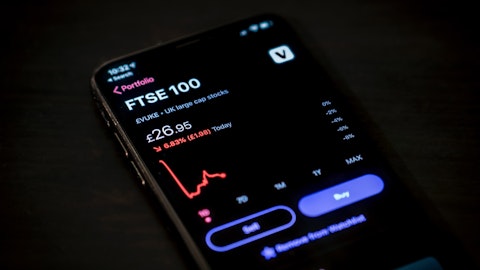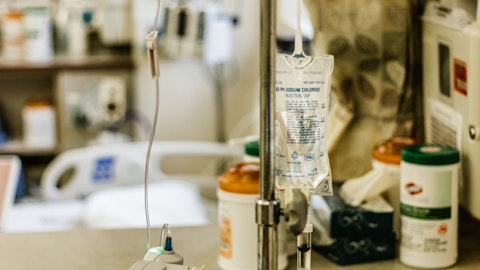Steve Collis: Thanks for the question.
Operator: Our next question next from Eric Percher from Nephron Research. Eric, your line is now open, please go ahead.
Eric Percher: Thank you. A question on US health care, I see you pretty consistently called out specialty to physician practices as a growth driver. And I noticed the last quarter or two, we haven’t seen mail called out, recognizing it could be reading too much into the — a few words here. But I’m curious, is there any change to distribution activity or self-distribution for the largest mail and specialty clients, and I know there’s been some discussion that we could see biosimilar source directly as we see larger volumes in the pharmacy benefit. Any thoughts on those trends?
Steve Collis: So, Eric, thanks for the question. No, we — AmerisourceBergen is focused on following the prescription dollar — so we have a broad segment of our customers, and I think it’s well known that Express Scripts Cigna is our lead customer in that area. They are a fast-growing customer and we’re not going to comment too specifically on them. But some of the customers do source Part D, more specifically Part D products directly and we’ll see that, that trend could continue. But it’s just really one segment of our portfolio of customers, and we’re happy with the relationship. We want to do the best job we can as a distributor for them. And the needs of large complex customers like Express Scripts are very different than the needs of some of our smaller customers that tend to use our services more readily. So, probably that’s all on that. Jim, anything you’d add?
Jim Cleary: I think that covers it. Thanks.
Operator: Our next question is from Charles Rhyee from Cowen. Charles, your line is now open, please go ahead.
Charles Rhyee: Yes, thanks for taking the questions. You mentioned before opportunistic share repurchases over the last few months. Can you talk about sort of what the capacity you have to continue to do that if, for example, Walgreens was to continue to take down its stake in the company, can you kind of give us a sense for sort of where you are in terms of that?
Jim Cleary: Yes. We obviously, we feel very good about the opportunistic share repurchases we’ve done over the past several months. And as you know, we’ve successfully collaborated with Walgreens on their two latest sales, repurchasing about $700 million in shares in conjunction with those sales. And we view these as a good opportunity to repurchase shares. And we continue to maintain a collaborative relationship with WBA. And we would expect to work together on any future plan sales, including potentially repurchasing shares. And that’s as a result of our very strong financial position, which continues, of course, and our focus on opportunistic share repurchases. And so if they do decide to sell additional shares, we would view it as an opportunity to repurchase.
Operator: Our next question is from George Hill from Deutsche Bank. George, your line is now open. Please go ahead.
George Hill: Good morning, guys and thanks for taking the questions. Jim, I’m going to take a shot at kind of two numbers related questions. I guess number one is with the closing of PharmaLex, can you say whether or not manufacturer services is now greater than 50% of gross profits in the International segment? And my brief follow-up would be is that if we look at the macro level, specialty drugs are now approaching 50% of kind of total sales in the Pharmaceutical segment. Is it safe to assume that, that mix is kind of reflective of ABC’s US drug sales mix as well? Thank you.
Jim Cleary: Yes, and so there was a lot there, and we specifically do not break out the percentage of manufacturer services. But I will say that those sorts of services are a really important part of our international business, just like they are in the US business. And I think one kind of key thing to call out is you’ll note that our operating margin is significantly higher in the International segment than it is in the US segment. And the reason for that is those higher-margin services businesses are a higher percentage of sales in our international segment than they are in the US segment. And they’re driven historically by things like World Courier, of course. But Alloga also, which is Alliance’s very successful 3PL business and some of alliances services business.
And now it’s an even greater percentage of the business given the exciting acquisition of PharmaLex. And so that’s just a little bit of commentary on the international market. And you asked about specialty products. In some cases, a number of the specialty products in the international market are 3PL. And so I think you also asked about the US business. And of course, specialty continues to be a driver for us in the US market, as you know, very well. And we’re a leader in the specialty business, both for physician practices and for non-physician parts of the business, and it’s really kind of a leading part of our legacy businesses that Steve started many years ago and a super important part of our future through our key partnerships.
George Hill: That’s helpful. Thank you.
Operator: Our next question is from Steven Valiquette from Barclays. Steven, your line is now open. Please go ahead.
Steve Collis: Steve, are you there?
Operator: Steven, your line is now open. You can proceed with your question.
Steve Collis: All right, we’ll go to the next question then Bruno.
Operator: No Problem. Our next question is from Eric Coldwell from Baird. Eric, your line is now open, please go ahead.
Eric Coldwell: Thanks very much. Two, if I might, and they’re both somewhat related in terms of when you first outlined the guardrails on fiscal 2023 outlook versus the updates today. First one, HUMIRA. I know pound-for-pound, it’s not as important as certain other drugs due to the channel of administration. But have your views changed at all now that we have front and center, we have the launch here? Have you had any change in perspective on the dynamics of that particularly large biosimilar in the market? And then second and somewhat correlated on the guidance timing through the last seven, eight months, whatever it is, the corporate name change in rebranding, maybe a bit of a silly question, but there will be some expenses associated with that absorbed in guidance or is it incremental?
I guess, when you first laid out the guardrails on fiscal 2023, were you assuming some expenses here or is this a newer topic that you’ve just subsequently absorbed? And if you could quantify that impact on the expense and capitalization side, it might be interesting? Thanks so much.
Steve Collis: Thanks. Good to hear from you Eric. So, I’ll start off. Obviously, we’ve talked about this for a while, and it seems like it was never going to be here. But of course, our first biosimilar HUMIRA launched this week, and it’s an important drug for the US health system, by some measures, the largest drug in history. And the introduction is going to be an important creator of headroom for the new innovative therapies that AmerisourceBergen is so well-positioned to serve our stakeholders in. So, that’s important. The first — so we’re interested to see how the trends go. And again, in July, we’ll see some more entrants, and some of them have different clinical aspects to them as you well know. But we’ve said consistently that Part B is our sweet spot.
This is very much a Part D drug, and it will be incrementally better for us in margins, but it’s mostly mail order. And as was pointed out previously, some of our Express Scripts, for example, and other customers in that category could be ordering directly, and they have limited locations, and it’s a much easier distribution function for manufacturers to fill. So, not — it won’t change our guidance or anything too much, but it is a very serious milestone in biosimilars, and we’ll look to see how the market absorbs this product. Jim, anything on the other guidance aspects?
Jim Cleary: Yes, Eric had asked about the name change and some of the costs and whatnot related to the name change. And Eric, we aren’t going to get into a lot of specifics at this time, but I will say that the spend will be spread out over the next three years, and it really happens in three phases. The first is planning and preparation, the second is launch, and the third is ongoing brand migration and a majority of these costs will be GAAP only as they are nonrecurring in nature. And then a portion of the cost will be capitalized and depreciated over time and recorded against our adjusted non-GAAP results. I’ll also comment that with regard to amortization of some of our existing trade names, there will be an increase in amortization expense, and it will be recorded and disclosed beginning in our March quarter and as a reminder, amortization expense relating to trade names is accounted for as a GAAP-only expense and is not included in our adjusted results.
Operator: Our next question is from Steven Valiquette from Barclays. Steven, your line is now open. Please go ahead.
Steven Valiquette: Great. Thanks. Good morning. Thanks for squeezing me back in here. Just a general question around Europe. There’s been some chatter in the marketplace about the possibility of expansion, the ability for entities in certain European countries to be able to potentially source drug inventory from other external European countries that may lead to lower drug costs. I guess I’m just curious if you have any high-level thoughts around this and at least maybe directionally, maybe talk about how this could impact your international operations. Thanks.
Steve Collis: Yes, so not a key area of focus for us. There is definitely a parallel trade market in Europe, which is actually highly regulated. But I haven’t heard that there’s any intention. This is not something we focus on. I haven’t heard that there’s any intention to expand that. And we really don’t have much further insight on that. Jim, do you agree?
Jim Cleary: Yes. Next question, please.




